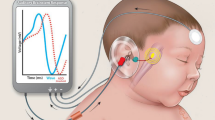Abstract
An automated auditory brainstem response (ABR) methodthe ALGO-1 Plus-has been developed for hearing screening in healthy neonates. The aim of this study was to test the validity of this automated ABR screening method in at-risk neonates in a neonatal intensive care unit. Two hundred and fifty at-risk neonates were selected for screening according to the criteria of the American Joint Committee on Infant Hearing. All 250 neonates were screened with the ALGO-1 Plus for bilateral hearing loss. When two consecutive screenings pointed to bilateral hearing loss (“refer”) further audiological investigations were performed and where necessary therapeutic measures were taken. All children who ”passed” the screening unilateral or bilateral enrolled in a nationwide behavioural screening programme at the age of 9 months as well as in a 6-monthly follow up programme documenting speech and language development. A total of 245 (98%) neonates passed the ALGO-1 screening, 230 (92%) at the first attempt and 15 (6%) at the second attempt. Five (2%) were referred with bilateral hearing loss. One of these died of congenital rubella shortly after screening and bilateral congenital hearing loss of >35 dB was confirmed in the other 4. None of the infants who passed the screening were discovered to have moderate to severe bilateral hearing loss (> 40 dB) with behavioural screening (n=183/233) or at follow up (n=233/233). In this study, all at-risk neonates with bilateral congenital hearing loss were detected with ALGO-1 Plus screening. No falsenegatives were discovered.
Similar content being viewed by others
Abbreviations
- ABR :
-
auditory brainstem response
- CPAP :
-
continuous positive airway pressure
References
Egan DF, Illingworth RS, Mac Keith RC (1969) Developmental screening 0–5 years. Clinics in Developmental Medicine 30: Heinemann, London
Ens-Dokkum M, Schreuder AM, Veen S (1992) Outcome at five years of age in very preterm and very low birthweight infants in the Netherlands Thesis. Pasmans, s Gravenhage
Galambos R, Hicks GE, Wilson MJ (1984) The auditory brainstem response reliably predicts hearing loss in graduates of a tertiary intensive care nursery. Ear Hear 5: 254–260
Hirasing RA, Dijk C van, Wagenaar-Fisher M et al (1991) Gehooronderzock in de jeugdgezondheidszorg. Ned Ver Jeugdgezondheidszorg. NVJG Utrecht
Jacobson JT, Jacobson CA (1994) The effects of noise in transient EOAE newborn hearing screening. Int J Pediatr Otorhinolaryngol 29 (3): 235–248
Jacobson JT, Jacobson CA, Spahr RC en (1990) Atitomated and conventional ABR screening technics in high-risk infants. J Am Acad Audiol 1: 187–195
Joint committee on infant hearing 1990. Position statement (1991) ASHA [Suppl] (5): 3–6
Kemp DT, Ryan S (1991) Otoacoustic emmision tests in neonatal screening programmes. Acta Otolaryngol [Suppl] 482: 73–84
Kileny PR (1988) New insights on infant ABR hearing screening. Scan Audiol [Suppl] 30: 81–88
Lem GJ vander, Baart de la Faille IL (1983) Early detection of hearing disorders in The Netherlands. Scan Audiol [Suppl] 17: 84–87
Markides A (1986) Age at fitting of hearing aids and speech intelligibility, Br J Audiol 20: 165–167
Martin WH, Schwegler JW, Gleeson AL, Shi YB (1994) New techniques of hearing assessment. Otolaryngol Clin North Am 27(B): 487–510
Peters JG (1986) An automated infant screener using advanced evoked response technology. Hear J 9: 1–4
Ramkalawan TW, Davis AC (1992) The effects of hearing loss and age at intervention on some language metrics in young hearing impaired children. Br J Audiol 26: 97–107
Robertson C, Aldridge S, Jarman F, Saunders K, Poulakis Z, Oberklaid F (1995) Late diagnosis of congenital sensorineural hearing impairment: why are detection methods failing? Arch. Dis Child 72: 11–15
Author information
Authors and Affiliations
Rights and permissions
About this article
Cite this article
van Straaten, H.L.M., Groote, M.E. & Oudesluys-Murphy, A.M. Evaluation of an automated auditory brainstem response infant hearing screening method in at risk neonates. Eur J Pediatr 155, 702–705 (1996). https://doi.org/10.1007/BF01957157
Received:
Accepted:
Issue Date:
DOI: https://doi.org/10.1007/BF01957157




